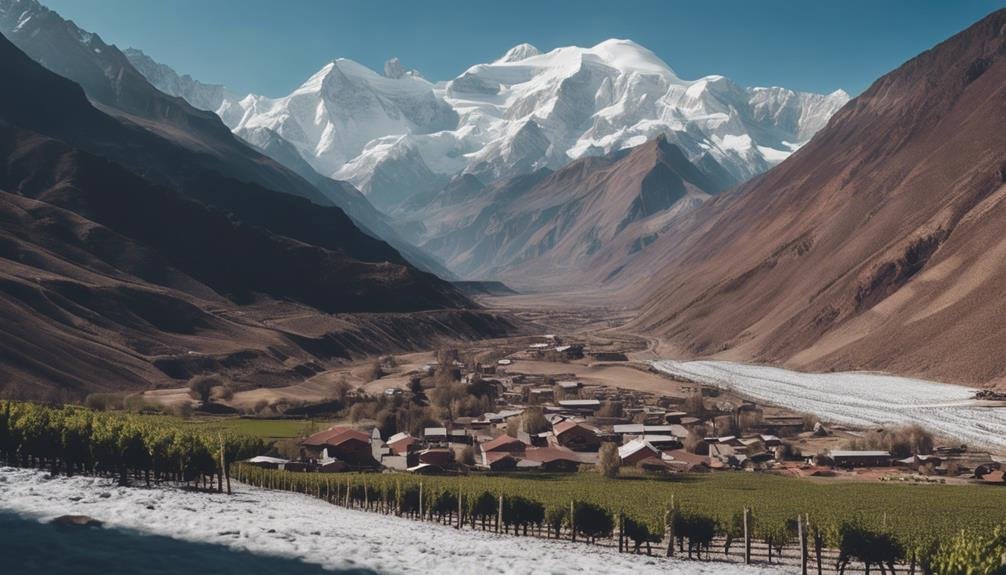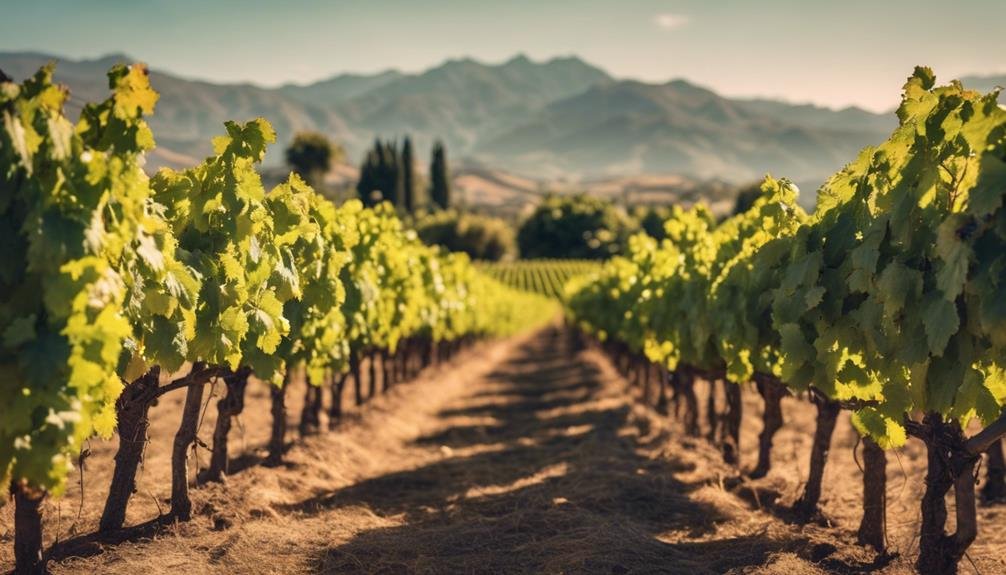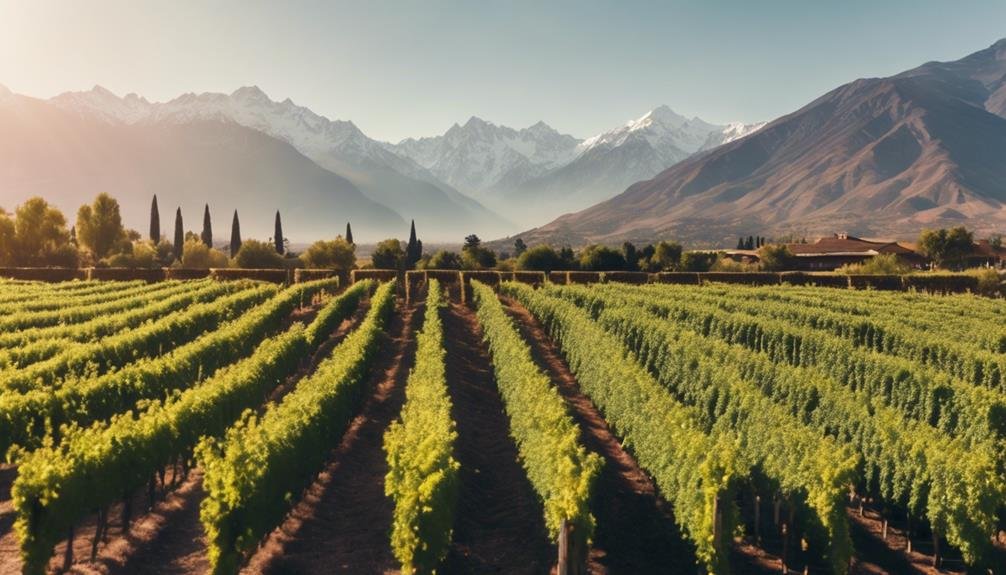Embark on a journey through Chilean Cabernet's flourishing wine regions where diverse terroirs and innovative winemaking converge. In Aconcagua, enjoy intense red wines with structured blends and subtle minerality. Maipo boasts Mediterranean Bordeaux blends, thanks to high-altitude vineyards enhancing complexity. Cachapoal offers elegant Cabernets with distinctive mineral notes, particularly in sub-regions like Alto Cachapoal. Producers like Viña Errazuriz, Santa Carolina, and Viña Los Boldos elevate the region's reputation. These regions showcase Chile's wine diversity and expertise, promising exceptional red wines with unique characteristics worth exploring further.
Chilean Wine History and Economy
The evolution of Chilean wine production and its economic impact were greatly influenced by the country's shift to democracy in the late 20th century. This political change opened doors for international investments in the Chilean wine industry.
With a focus on Bordeaux varieties and innovative winemaking techniques, Chile began to increase its wine exports substantially. This surge in exports not only brought international recognition but also bolstered the country's economy.
Major US and French wineries recognized the potential of Chilean terroir and invested in operations within the country. This influx of foreign investment further propelled Chilean wines onto the global stage, establishing a reputation for quality and distinctiveness.
Exploration of Chiles Wine Regions
Democracy's transformative impact on Chilean wine paved the way for a dynamic exploration of the country's diverse wine regions. Terroir influence and vineyard diversity play significant roles in defining Chile's wine landscape.
The climate impact and winemaking techniques vary across the North, Central, and South zones, contributing to the unique characteristics of each region's wines. The North and South regions are known for their innovative winemaking practices, while the Central region boasts a classic wine-growing history.
Major wine-producing valleys like Aconcagua, Maipo, Colchagua, and Cachapoal showcase the country's rich viticultural heritage. Understanding how these factors interact in different regions allows for the production of exceptional wines that reflect Chile's terroir and climate in each bottle.
Aconcagua: Intense Red Wines

With a backdrop of sun-drenched slopes and terraced vineyards, Aconcagua embodies the essence of intensity in its red wines. Aconcagua's terraced vineyards provide the perfect setting for cultivating Bordeaux blends in the region's sunny and dry conditions. The best vineyard sites, located on slopes and terraces, yield intensely structured red wines with high acidity.
The Bordeaux-style blends from Aconcagua showcase subtle notes and minerality, reflecting the unique terroir of the area. Notable producers such as Viña Errazuriz, Viña von Siebenthal, and Viña San Esteban are at the forefront of crafting these exceptional wines. Aconcagua stands out for its ability to produce red wines of remarkable depth and complexity, making it a must-visit region for wine enthusiasts seeking bold flavors and rich textures.
Maipo: Mediterranean Bordeaux Blends
Nestled along the Maipo river valley, the region of Maipo is renowned for producing Mediterranean Bordeaux blends that captivate wine enthusiasts with their distinctive characteristics.
- Alto Maipo – Home to some of the most prestigious vineyards in Chile, the high-altitude vineyards of Alto Maipo impart complexity to the wines, enhancing their structure and flavors.
- Bordeaux Varietals – Maipo excels in cultivating classic Bordeaux varietals such as Cabernet Sauvignon, Merlot, and Cabernet Franc, resulting in elegant and full-bodied red blends reminiscent of the renowned Napa Valley wines.
- Terroir Influence – The unique terroir of Maipo, with its Mediterranean climate and excellent soil conditions, plays a pivotal role in shaping the distinct flavor profiles and exceptional quality of wines produced in this region.
Cachapoal: Elegant Mineral Cabernets

Renowned for its elegant mineral Cabernets, the Cachapoal region in Chile stands out for producing wines that showcase distinctive terroir-driven characteristics. Sub-regions like Alto Cachapoal offer tart cherry flavors, enhancing the overall complexity of the wines.
Bordeaux blends and Carménère from this area are particularly notable for their minerality, adding a unique touch to each sip. Among these, the highlighted sub-region of Peumo is renowned for its balanced Cabernet Sauvignon, reflecting the region's expertise in crafting wines with finesse and depth.
Producers such as Lagar de Bezana, Vik, Santa Carolina, Concha Y Toro, and Viña Los Boldos contribute to the region's reputation for producing elegant and sophisticated wines that capture the essence of Cachapoal's terroir.
Frequently Asked Questions
What Impact Did Chiles Transition to Democracy Have on the Wine Industry?
The shift to democracy in Chile had a significant impact on the wine industry by fostering economic growth, encouraging innovation, and creating export opportunities. This change facilitated commerce, attracting investments and leading to increased international recognition.
How Have International Investments Influenced Chilean Winemaking?
International partnerships have greatly influenced Chilean winemaking, bringing in innovative techniques and expertise. Collaborations with US and French wineries have elevated quality standards, expanded market reach, and introduced new winemaking methods, enhancing the industry's global reputation.
What Sets Aconcaguas Terraced Vineyards Apart From Other Regions?
Aconcagua's terraced vineyards stand out for their innovative cultivation techniques and unique climate. The sunny, dry conditions in this region create intensely structured red wines with high acidity. Bordeaux-style blends from Aconcagua exhibit subtle notes and minerality.
Why Is Maipo Considered a Sweet Spot for Bordeaux Varieties?
Maipo stands out as a prime region for Bordeaux varietals due to its unique microclimates. These conditions mirror those of Bordeaux, resulting in full-bodied red blends akin to Napa Valley's finest. The combination of Maipo's terroir and weather creates exceptional wines.
What Makes the Sub-Region of Peumo in Cachapoal Stand Out for Cabernet Sauvignon?
Peumo in Cachapoal stands out for Cabernet Sauvignon due to its unique terroir. The region's soil and climate offer a distinctive minerality and balance to the wines. Peumo's excellence in producing Cabernet Sauvignon showcases the sub-region's quality and character.
Conclusion
To sum up, Chile's thriving Cabernet regions showcase the country's diverse landscape and rich viticultural history. With Aconcagua's intense red wines, Maipo's Mediterranean Bordeaux blends, and Cachapoal's elegant mineral Cabernets, Chile continues to make its mark in the global wine industry.
Like a well-aged Cabernet, Chilean wine production has matured over the years, evolving into a complex and nuanced industry that captivates wine enthusiasts worldwide.
